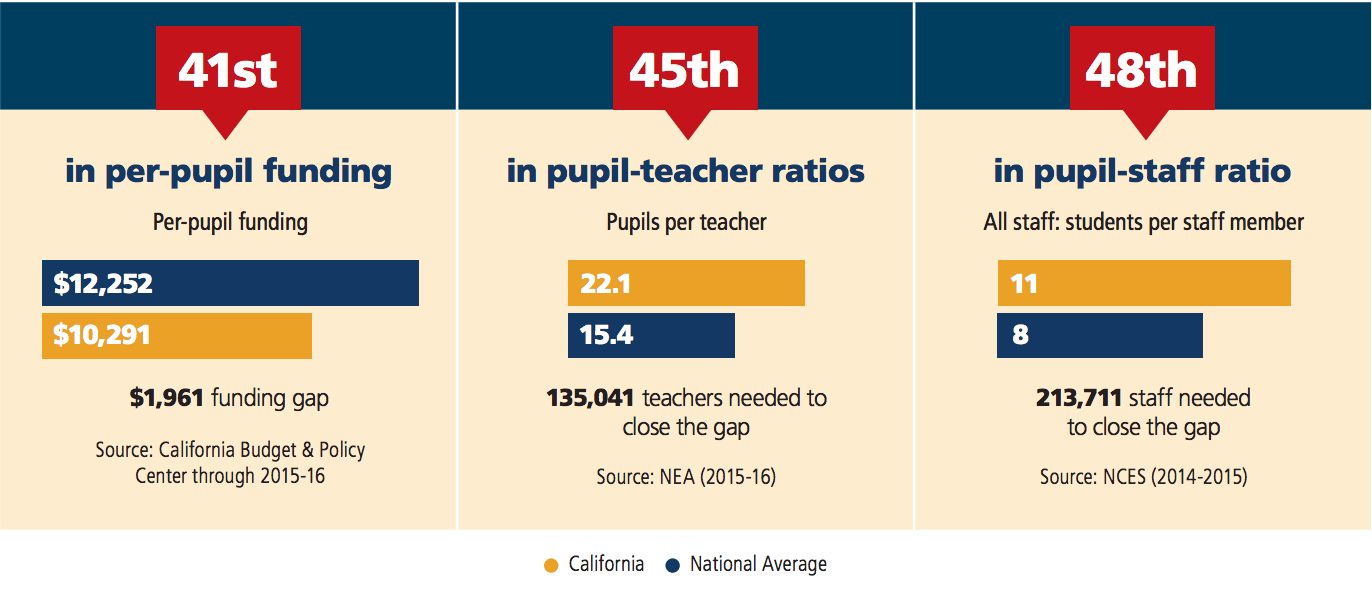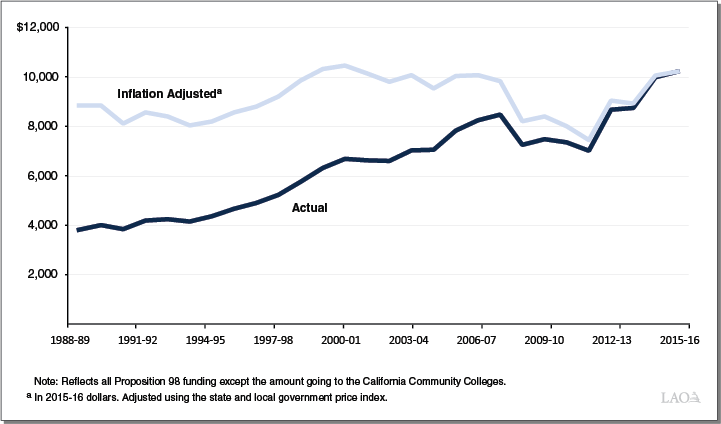Another Skimpy Budget for California Education

Sorry, Kids.
On the surface, California's new draft budget seems great. With the economy roaring and the stock market soaring, the Governor's proposed budget for 2018-19 hits some new highs. Among other things, it funds education at levels that satisfy the minimum bars set decades ago by California's voters and legislators.
But let's be clear: those minimum bars are awfully low.
A Bright Moment
The headlines you might hear about the proposed budget are good news. Here are a few details. Don't let them distract you.
Here are some details. Don't let them distract you. This budget doesn't make California's schools well-funded.
Yes, it meets the minimum legal requirements. Three decades ago, California voters passed Proposition 98, which required state legislators to commit a bigger fraction of the budget to public education. Every year at budget time the education establishment obsesses over the question of whether the budget satisfies the letter of the law. In rough budget years, the legislature has been known to "suspend" Prop 98, in effect borrowing from the education budget to pay for other priorities. This year's budget proposal requires no such shenanigans; it satisfies the minimum requirement.
Yes, it "fully funds" the Local Control Funding Formula. In 2013, responding to a deep budget crunch, California's legislature deeply revised and simplified the rules for allocating funds to school districts. The Local Control Funding Formula (LCFF) provides school districts a "base" amount for each student in attendance, plus some additional money for students that are low-income, learning English or in foster care. With the proposed budget, the transition to LCFF is complete, two years ahead of forecast.
Yes, it sets aside money in a "rainy day" fund. Because the California budget depends heavily on personal income taxes, it is very susceptible to dips in the stock market. When the sun shines on Wall Street (as it has done for the last year), California's investors earn capital gains and pay taxes on them. But every bull market ends. The rainy day fund will help smooth out the inevitable revenue potholes ahead, perhaps protecting future budgets from moves to suspend the rules and "borrow" again from funds for public education.
Yes, it includes some specific investments. The budget commits some new money, mostly on a one-time basis, to specific programs. For example, it directs $100 million toward easing the state's acute shortage of special education teachers. It directs about $200 million toward investments in career technical education, and invests in a new funding model for community colleges. It expands funding for the California Collaborative for Education Excellence (CCEE), an agency created to support districts and schools that are persistently struggling. It delivers on a promise to modestly expand preschools, and begins investment in the Nurse-Family Partnership, a promising program that offers training for new or expecting mothers.
And yes, it will probably increase. The Governor's January budget proposal is cautious. For example, there is a risk that gridlock over the Federal budget might interrupt food aid for needy children. It probably won't happen, but the Governor's January budget proposal sets aside money to cover the program for California, just in case. If bad things don't happen, there could be room for education spending to expand in the coming few months. The next big step in the budget process is the "May Revision." (Here's a handy infographic of how the process works.)
A Long Way to Go
Despite the relieving news above, this budget doesn't fix the big picture reality: California remains very far behind when it comes to investing in the well-being and future prospects of children. Adjusted for inflation, this budget basically takes K-12 education funding back to levels it has visited before:
Sorry, little ones. Early education is vitally important, and almost certainly pays the state back in the long run. But budgets aren't long-term. California doesn't have enough little seats to provide preschool for everyone and this budget doesn't chip away at the gap. For each child, preschool is a once-in-a-lifetime opportunity. In rough numbers, every year California misses at least 100,000 chances to send a child to Kindergarten ready to learn. California isn't the worst in America on this metric, but does it have to be a contender?
Another year, another 100,000 kids unready for kindergarten.
Where's the effort? States vary in the kinds of taxes and revenue structures they use to fund schools, which can make comparisons difficult. In the end, the best way to measure effort is to look at the bottom line: how does the amount spent on public education in each state compare to the amount of money in the state's economy? On this measure, California routinely places in the bottom ten among the states. (See table 4 in the 2017 NEA Rankings and Estimates or, for a historical perspective see the States In Motion series on EdSource.) The proposed budget won't change that. ChildrenNow, a California non-profit focused on advocacy for kids, points out that the proposed budget actually shrinks the percentage of the California budget committed to K-12 education.

Side note: National and state-level education data sources are never timely. At the moment, 2014-5 data are the freshest vintage available from the National Center for Education Statistics to compare the percentage of taxable income by state spent on education.
You Get What You Pay For. Money does not have magical powers that cause children to learn, but the lack of it certainly hurts. The California School Boards Association (CSBA) has been using this moment to point out that California's investment in the education of each child routinely trails the national average by about $2,000 per student per year.

Costs will go up. Nobody gets rich teaching, but pay does matter. To work as a teacher requires a college degree, a place to live, health insurance and a ride to work. The cost of those things is rising faster than inflation. So, too, is the cost of providing teachers with the long-term security of a pension. With the arrival of a little more money in the budget, your school board will probably face the question of whether to raise teacher pay to keep pace with these pressures. But to improve education for kids in California will probably require resources to do more than merely keep up.
Still Skimpy
The proposed budget adds money for schools, but not enough to change the fundamental conditions of education in this state. California is a high-cost place that perennially places a low priority on funding for education.
Tags on this post
Budgets Funding LCFF Special ed CSBAAll Tags
A-G requirements Absences Accountability Accreditation Achievement gap Administrators After school Algebra API Arts Assessment At-risk students Attendance Beacon links Bilingual education Bonds Brain Brown Act Budgets Bullying Burbank Business Career Carol Dweck Categorical funds Catholic schools Certification CHAMP Change Character Education Chart Charter schools Civics Class size CMOs Collective bargaining College Common core Community schools Contest Continuous Improvement Cost of education Counselors Creativity Crossword CSBA CTA Dashboard Data Dialogue District boundaries Districts Diversity Drawing DREAM Act Dyslexia EACH Early childhood Economic growth EdPrezi EdSource EdTech Education foundations Effort Election English learners Equity ESSA Ethnic studies Ethnic studies Evaluation rubric Expanded Learning Facilities Fake News Federal Federal policy Funding Gifted Graduation rates Grit Health Help Wanted History Home schools Homeless students Homework Hours of opportunity Humanities Independence Day Indignation Infrastructure Initiatives International Jargon Khan Academy Kindergarten LCAP LCFF Leaderboard Leadership Learning Litigation Lobbyists Local control Local funding Local governance Lottery Magnet schools Map Math Media Mental Health Mindfulness Mindset Myth Myths NAEP National comparisons NCLB Nutrition Pandemic Parcel taxes Parent Engagement Parent Leader Guide Parents peanut butter Pedagogy Pensions personalized Philanthropy PISA Planning Policy Politics population Poverty Preschool Prezi Private schools Prize Project-based learning Prop 13 Prop 98 Property taxes PTA Purpose of education puzzle Quality Race Rating Schools Reading Recruiting teachers Reform Religious education Religious schools Research Retaining teachers Rigor School board School choice School Climate School Closures Science Serrano vs Priest Sex Ed Site Map Sleep Social-emotional learning Song Special ed Spending SPSA Standards Strike STRS Student motivation Student voice Success Suicide Summer Superintendent Suspensions Talent Teacher pay Teacher shortage Teachers Technology Technology in education Template Test scores Tests Time in school Time on task Trump Undocumented Unions Universal education Vaccination Values Vaping Video Volunteering Volunteers Vote Vouchers Winners Year in ReviewSharing is caring!
Password Reset
Search all lesson and blog content here.
Login with Email
We will send your Login Link to your email
address. Click on the link and you will be
logged into Ed100. No more passwords to
remember!





 Source: California LAO
Source: California LAO








Questions & Comments
To comment or reply, please sign in .